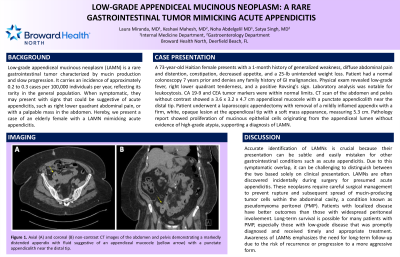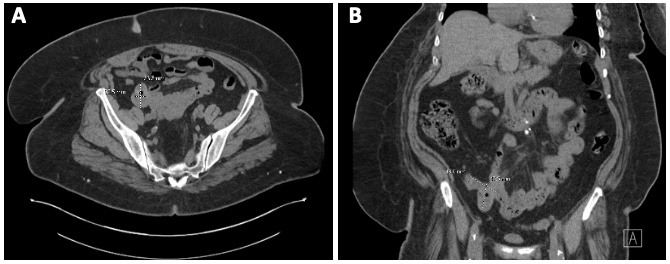Monday Poster Session
Category: Colon
P2100 - Low-Grade Appendiceal Mucinous Neoplasm: A Rare Gastrointestinal Tumor Mimicking Acute Appendicitis
Monday, October 28, 2024
10:30 AM - 4:00 PM ET
Location: Exhibit Hall E

Has Audio

Laura Miranda, MD
Broward Health North
Pompano Beach, FL
Presenting Author(s)
Laura Miranda, MD1, Keshavi Mahesh, MD1, Noha Abdelgelil, MD2, Satya Singh, MD3
1Broward Health North, Pompano Beach, FL; 2Broward Health North, Deerfield Beach, FL; 3Broward Health Medical Center, Fort Lauderdale, FL
Introduction: Low-grade appendiceal mucinous neoplasm (LAMN) is a rare gastrointestinal tumor characterized by mucin production and slow progression. It carries an incidence of approximately 0.2 to 0.3 cases per 100,000 individuals per year, reflecting its rarity in the general population. When symptomatic, they may present with signs that could be suggestive of acute appendicitis, such as right lower quadrant abdominal pain, or with a palpable mass in the abdomen. Hereby, we present a case of an elderly female with a LAMN mimicking acute appendicitis.
Case Description/Methods: A 73-year-old Haitian female presents with a 1-month history of generalized weakness, diffuse abdominal pain and distention, constipation, decreased appetite, and a 25-lb unintended weight loss. Patient had a normal colonoscopy 7 years prior and denies any family history of GI malignancies. Physical exam revealed low-grade fever, right lower quadrant tenderness, and a positive Rovsing's sign. Laboratory analysis was notable for leukocytosis. CA 19-9 and CEA tumor markers were within normal limits. CT scan of the abdomen and pelvis without contrast showed a 3.6 x 3.2 x 4.7 cm appendiceal mucocele with a punctate appendicolith near the distal tip. Patient underwent a laparoscopic appendectomy with removal of a mildly inflamed appendix with a firm, white, opaque lesion at the appendiceal tip with a soft mass appearance, measuring 5.3 cm. Pathology report showed proliferation of mucinous epithelial cells originating from the appendiceal lumen without evidence of high-grade atypia, supporting a diagnosis of LAMN.
Discussion: Accurate identification of LAMNs is crucial because they can be easily mistaken for other gastrointestinal conditions such as acute appendicitis. This symptomatic overlap can make it challenging to distinguish between the two based solely on clinical presentation. LAMNs are often discovered incidentally during appendectomies. These neoplasms require careful surgical management to prevent rupture and subsequent spread of mucin-producing tumor cells within the abdominal cavity, a condition known as pseudomyxoma peritonei (PMP). Patients with localized disease have better outcomes than those with widespread peritoneal involvement. Long-term survival is possible for many patients with PMP, especially those with low-grade disease that was promptly diagnosed and treated. Awareness of LAMNs emphasizes the need for close follow-up due to the risk of recurrence or progression to a more aggressive form.

Disclosures:
Laura Miranda, MD1, Keshavi Mahesh, MD1, Noha Abdelgelil, MD2, Satya Singh, MD3. P2100 - Low-Grade Appendiceal Mucinous Neoplasm: A Rare Gastrointestinal Tumor Mimicking Acute Appendicitis, ACG 2024 Annual Scientific Meeting Abstracts. Philadelphia, PA: American College of Gastroenterology.
1Broward Health North, Pompano Beach, FL; 2Broward Health North, Deerfield Beach, FL; 3Broward Health Medical Center, Fort Lauderdale, FL
Introduction: Low-grade appendiceal mucinous neoplasm (LAMN) is a rare gastrointestinal tumor characterized by mucin production and slow progression. It carries an incidence of approximately 0.2 to 0.3 cases per 100,000 individuals per year, reflecting its rarity in the general population. When symptomatic, they may present with signs that could be suggestive of acute appendicitis, such as right lower quadrant abdominal pain, or with a palpable mass in the abdomen. Hereby, we present a case of an elderly female with a LAMN mimicking acute appendicitis.
Case Description/Methods: A 73-year-old Haitian female presents with a 1-month history of generalized weakness, diffuse abdominal pain and distention, constipation, decreased appetite, and a 25-lb unintended weight loss. Patient had a normal colonoscopy 7 years prior and denies any family history of GI malignancies. Physical exam revealed low-grade fever, right lower quadrant tenderness, and a positive Rovsing's sign. Laboratory analysis was notable for leukocytosis. CA 19-9 and CEA tumor markers were within normal limits. CT scan of the abdomen and pelvis without contrast showed a 3.6 x 3.2 x 4.7 cm appendiceal mucocele with a punctate appendicolith near the distal tip. Patient underwent a laparoscopic appendectomy with removal of a mildly inflamed appendix with a firm, white, opaque lesion at the appendiceal tip with a soft mass appearance, measuring 5.3 cm. Pathology report showed proliferation of mucinous epithelial cells originating from the appendiceal lumen without evidence of high-grade atypia, supporting a diagnosis of LAMN.
Discussion: Accurate identification of LAMNs is crucial because they can be easily mistaken for other gastrointestinal conditions such as acute appendicitis. This symptomatic overlap can make it challenging to distinguish between the two based solely on clinical presentation. LAMNs are often discovered incidentally during appendectomies. These neoplasms require careful surgical management to prevent rupture and subsequent spread of mucin-producing tumor cells within the abdominal cavity, a condition known as pseudomyxoma peritonei (PMP). Patients with localized disease have better outcomes than those with widespread peritoneal involvement. Long-term survival is possible for many patients with PMP, especially those with low-grade disease that was promptly diagnosed and treated. Awareness of LAMNs emphasizes the need for close follow-up due to the risk of recurrence or progression to a more aggressive form.

Figure: Axial (A) and coronal (B) non-contrast CT images of the abdomen and pelvis demonstrating a markedly distended appendix with fluid suggestive of an appendiceal mucocele with a punctate appendicolith near the distal tip.
Disclosures:
Laura Miranda indicated no relevant financial relationships.
Keshavi Mahesh indicated no relevant financial relationships.
Noha Abdelgelil indicated no relevant financial relationships.
Satya Singh indicated no relevant financial relationships.
Laura Miranda, MD1, Keshavi Mahesh, MD1, Noha Abdelgelil, MD2, Satya Singh, MD3. P2100 - Low-Grade Appendiceal Mucinous Neoplasm: A Rare Gastrointestinal Tumor Mimicking Acute Appendicitis, ACG 2024 Annual Scientific Meeting Abstracts. Philadelphia, PA: American College of Gastroenterology.
